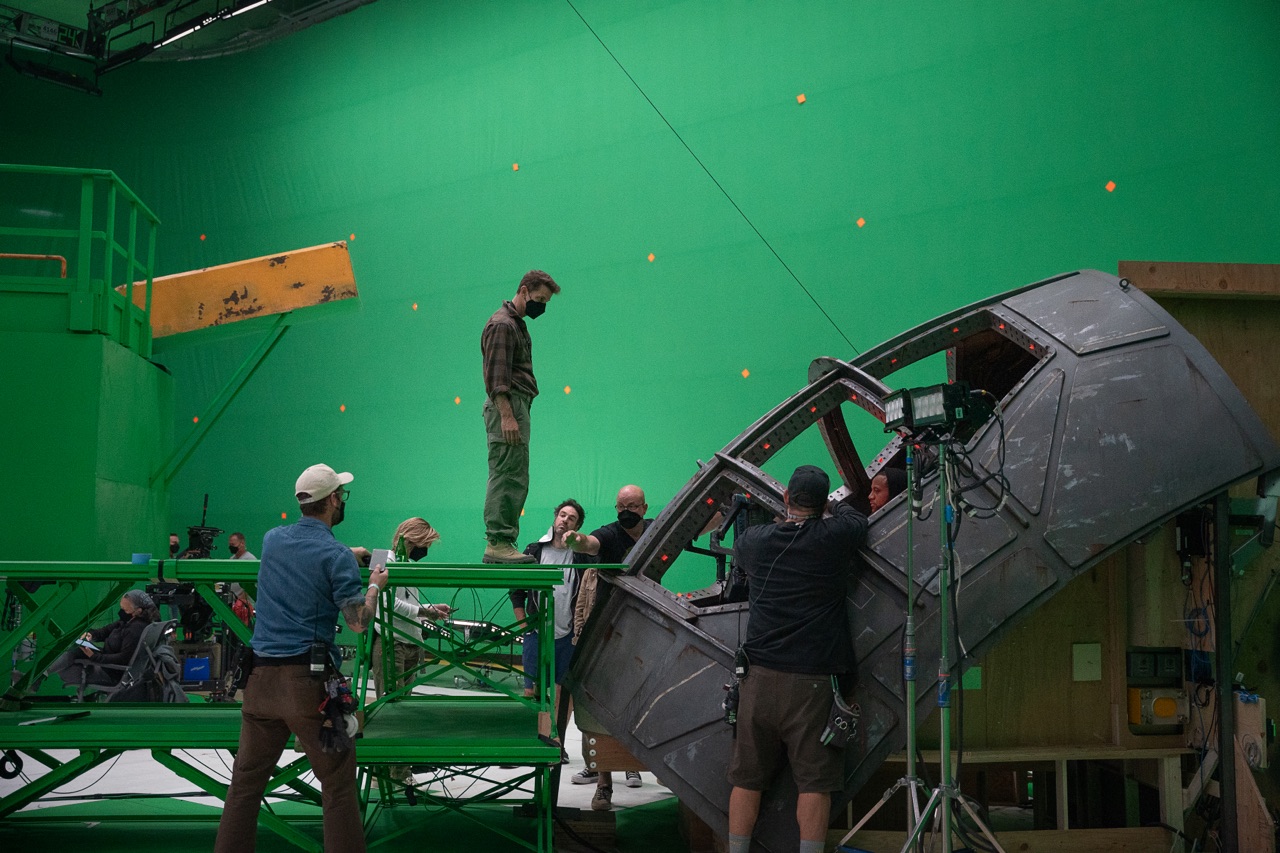Behind the visual effects of Zack Snyder’s Rebel Moon – Part One: A Child of Fire.
With Rebel Moon – Part One: A Child of Fire, director Zack Snyder goes big on worldbuilding.
To aid in the portrayal of distant planets, spaceships, creatures and battles, Snyder turned to his Army of the Dead collaborator, visual effects supervisor Marcus Taormina.
Taormina was the on-set supervisor and supervisor in post, sharing effects supervision duties with John ‘D.J.’ Des Jardin when he had to move onto Rebel Moon Part 2 – The Scargiver. Tamara Watts Kent and David Robinson shared visual effects producing responsibilities. Recruited to provide visual effects for the film were Framestore, Scanline VFX, Wētā FX, Rodeo FX, Luma Pictures, Mammal Studios and an in-house team.
Here, visual effects supervisor Marcus Taormina breaks down for befores & afters just some of the biggest VFX challenges on the film; from the creature work for the bennu, uraki, Harmada and King Levitica, to the robot Jimmys, and even down to designing muzzle flashes.
Creating familiar surroundings
b&a: One of my really first reactions to the film was that you have managed to create very familiar surroundings for an audience, but within these alien worlds. There are just all these familiarities to it, like a western type feel sometimes, or a grungy, gritty feel. Was that something very clear from the beginning that Zack wanted to do and you wanted to do?
Marcus Taormina: Yes. I appreciate you saying that because you nailed it. In pre-production, we finally found our Veldt. At first, we were questioning – “What does Veldt look like?” Our production designers Stefan Dechant and Stephen Swain did a great job at designing Veldt, and as those still frames became tangible objects that we could start to walk through, we then thought about, ‘Okay, now that feels like a grungier village.’ And then Zack created these custom, one-of-a-kind anamorphic lenses for this movie. He does it to me again, where it’s like, ‘Okay, the Dream lenses from Army of the Dead weren’t hard enough. Let’s do these. It’s anamorphic, at a shallow depth of field: and they’re custom glass!’ The lenses had a vintage grunge feel to them and, while I loved the final look, they gave me headaches all through shoot and post.
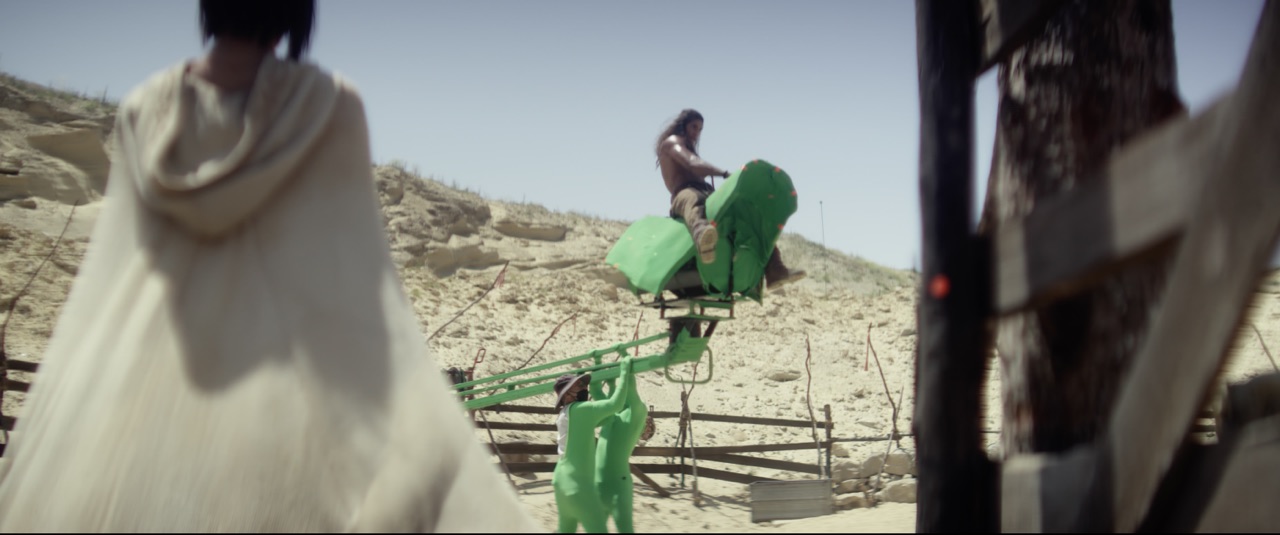

Then when we got into spaceships landing, we decided, ‘You know what? Let’s build a practical spaceship, first of all, so there’s something for the cast to interact with.’ But when they’re landing, it was, ‘Yeah, I know I could do this dust simulation artificially, but why don’t we get a helicopter pass to do it practically?’ It’s things like that which add more grunge and believability to the scenes.
Sometimes there’s a very clinical, clean quality to certain sci-fi movies, and Zack felt we were not going to do that. I said, ‘Zack, can I pelt the lens with digital dirt?’ And he’s like, ‘Yeah, absolutely.’ So I said, ‘Can I do it more? Can I put more on top of this lens?’ And Zack said, Sure!’. Flares? “Yes!”. Water droplets on the lens? “Absolutely!”. He knew we were striving to match the practical imagery he worked so hard to create.
That made things feel more real, and more familiar. We all know what a dust wash feels like. We’ve seen some version of it either in films or in real life. So, that grungy quality also went along with all the environments we created. But then to make it relatable, we had a lot of discussions about what each environment is–who lives there? What do we want it to feel like? What’s the color palette? What creatures are in these environments? Are they ground dwellers? It’s all the things like that, where those discussions help make the effects look good, even though no one’s aware of those conversations besides me, Zack, our editorial team, and all the artists working on the shots.
Your brain goes, ‘I know what heavy, socked-in atmospherics look like, but this is weird. This is different. But I like it because it feels familiar.’ And so that also helps, I think, as the viewers feel that too, where you suddenly feel cold when you’re on Gondival because it’s like a stark, foggy planet, but it’s wet and damp, and you feel that in your bones. That’s what we strived for in all of the work that we did.
Crafting uraki
b&a: Even to begin with, the horse-like uraki creatures that they’re riding on Veldt, are they just horses where you’ve augmented, or are they bucks with CG creature work?
Marcus Taormina: I’m glad that you’re like, ‘I’m not sure how it was done…’. They’re actually these show horses, which are massive horses. We talked about bucks, but it was just too complicated and time consuming. Very early on in pre-production, we just did some techvis, where we said, ‘If we take a horse of this scale and we add our creature, what technical challenges does that pose?’ We had to squeeze our creature just a bit, but enough that we actually took the majority of the horse body, and we just seamed it at the neck or sometimes just at the head right behind the jawline.
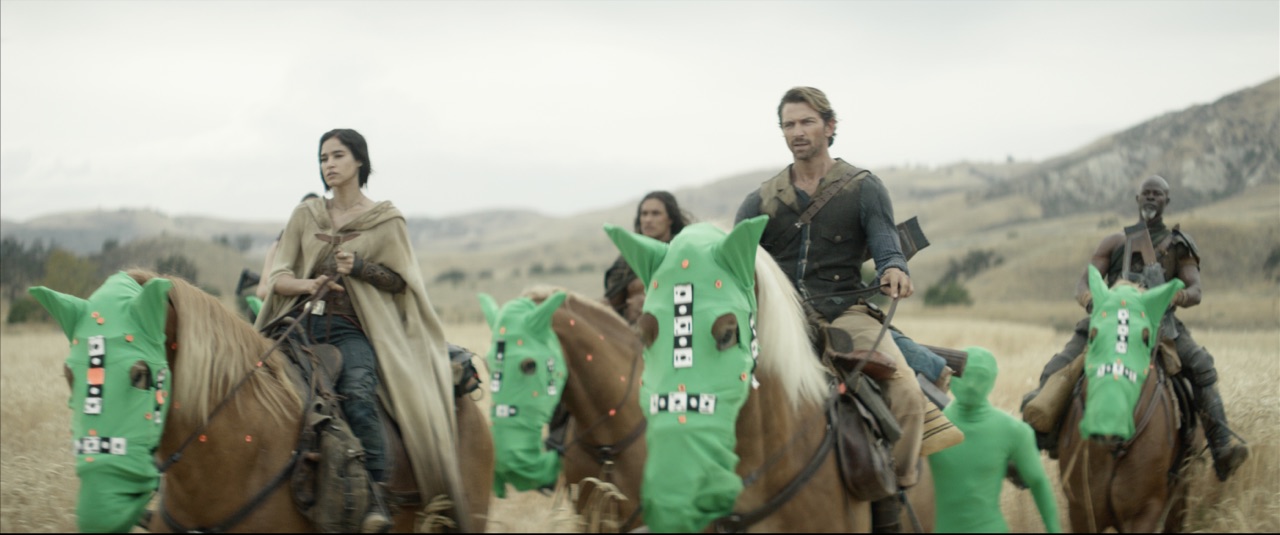

On set, we had to have these horses with these big green hoods and then marker-up their necks every day. Some of the horses hated the hoods, Hercules in particular, so they would chew them, and then the hoods would fall down and come unravelled. This meant a lot more paint work and background reconstruction behind that floppy hood, so I was always saying to myself ‘Ah, man!’ while still realizing, ‘They’re horses’, it’s what makes these shots have an organic feeling to them. I’d run in there in-between takes sometimes trying to pin the hoods back so it didn’t fall off while everyone is looking at me, wondering what I’m doing out there, holding the shoot crew up, but it was always for the better of the FX work in the end.
So, the uraki are really fun creatures and subtly done. I think we tried to do subtle enough, where they just kind of live in the moment, and you’re like, ‘Oh, that’s cool. Space horses – moving on.’
Making a Jimmy
b&a: Subtle is another thing I wanted to talk about, especially for JC-1435. Again I wasn’t sure completely how you made it. Is this Jimmy a partial human performer, or is it motion capture? Is it a bit of both? How did you accomplish that?
Marcus Taormina: I love that you asked that question because that was the conversation that I had with Zack in post-production, that we wanted to fool the audience to go, ‘Is that mo-cap? Is that a guy in a robot suit? Is that…?’ The art department created this beautiful chest piece that you see in the film with the filigree and the patina on it and the faceplate as well, the whole head, actually. They created it digitally and then Fractured FX manufactured it, and we found a stunt performer, Dustin Ceithamer, who we fit to. He’s actually in a blue suit with the chest-plate, the full face with a little piece of it taken out so he could see through, and then he had shoulder pieces as well.

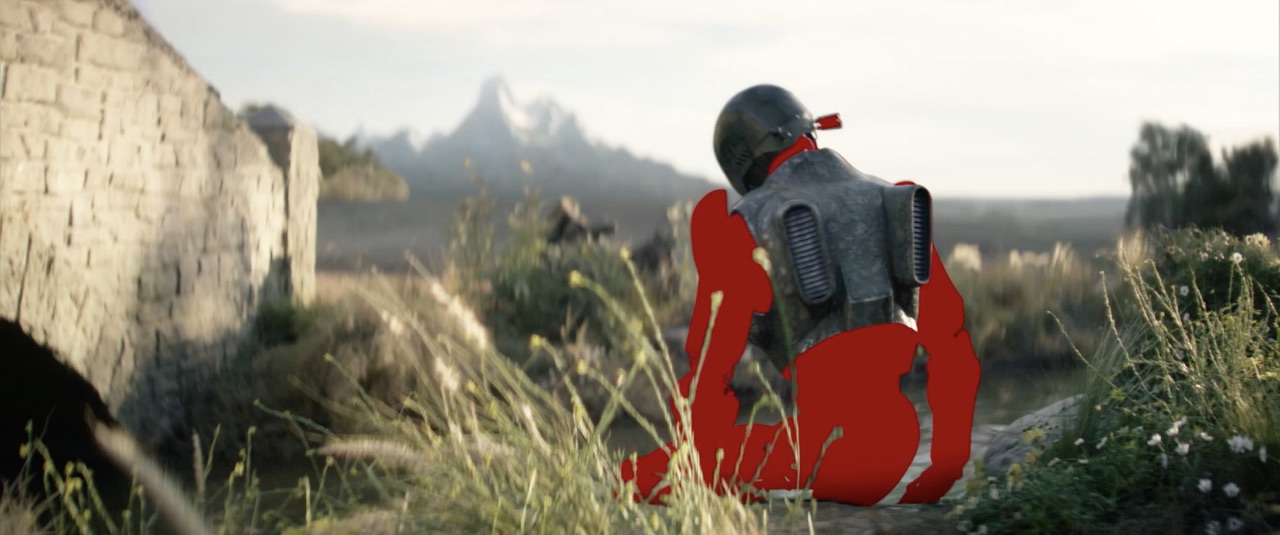


The thing that I love that you hit on is that in post-production, we could have replaced the whole thing. But I did not want to do that. There’s this richness of the world and the way that the light scatters across that filigree, especially when he’s at the river, the caustics and how they reflect on there. I said, ‘Why would we ever replace that?’ So I mandated that we keep the head and the chest-plate everywhere that we could. The Scanline team led by Justin Mitchell did an amazing job of doing exactly that.
Then the internals were all digital, and we added some subtle glow to them. But knowing the design before we shot, I could go in and talk to Dustin about things that he shouldn’t do, because there were gears and stuff in here that he didn’t know about. So I’d say, ‘Don’t do that because it’s going to collide in post.’ He was just such a great performer, and he heard all my notes along the way.
What was also good about Jimmy is that we did scratch tracks with Anthony Hopkins before we shot the scenes. So we gave those to Dustin to study so there wouldn’t be a mismatch from Anthony’s delivery against Dustin’s movement. And when we first did it, Zack was like, ‘You’re not really a robot. We want you to kind of feel like a human. We’ll add the internals later.’ Then when we got along the way, we said, ‘These performances are so good, and he feels like he’s there. And he looks like a robot, and we love him, but how can we make him a little bit warmer or a little more human-like?’
That’s where the subtlety comes in because we had to limit ourselves and say, ‘You know what? We can do all sorts of things creatively, but why? It’s there. So let’s add a familiar blush of the cheeks to Jimmy and a subtle faceplate shift, so he does a little brow movement mimicking a human and just relatable, human qualities like that.’
With things like this, there can be the talk of the Uncanny Valley. That’s why those things are uncanny, because our brains know what a brow furrow looks like and a blush feels like. So we didn’t want to go uncanny, obviously, but we took those opportunities that are familiar to human beings and infused them into Jimmy, but in a subtle way. I like to do that through all the effects, just keep them subtle, because if you’re hitting the audience over the head with it, then they’re going to know it’s digital. It’s always my goal to blend the seams together.
The art of muzzle flashes and ship exhausts
b&a: One thing I really loved in the gunfights were muzzle flashes, especially in slow motion. There were also great exhausts from spaceships, and you mentioned the dust wakes from landings and take-offs. I bet you had a lot of conversations with Zack about muzzle flashes.
Marcus Taormina: For sure. On Army of the Dead, we had discussions about muzzle flashes. And on this one, it was more extensive, and we actually improved a lot of the interactive that we had on set. When we could, we shot a lot of these light pucks. They would go into the end, and they would actually flare the camera, which is cool, but it’s also a nightmare for us later on. So we had to paint all those out and track in a partial CG gun.

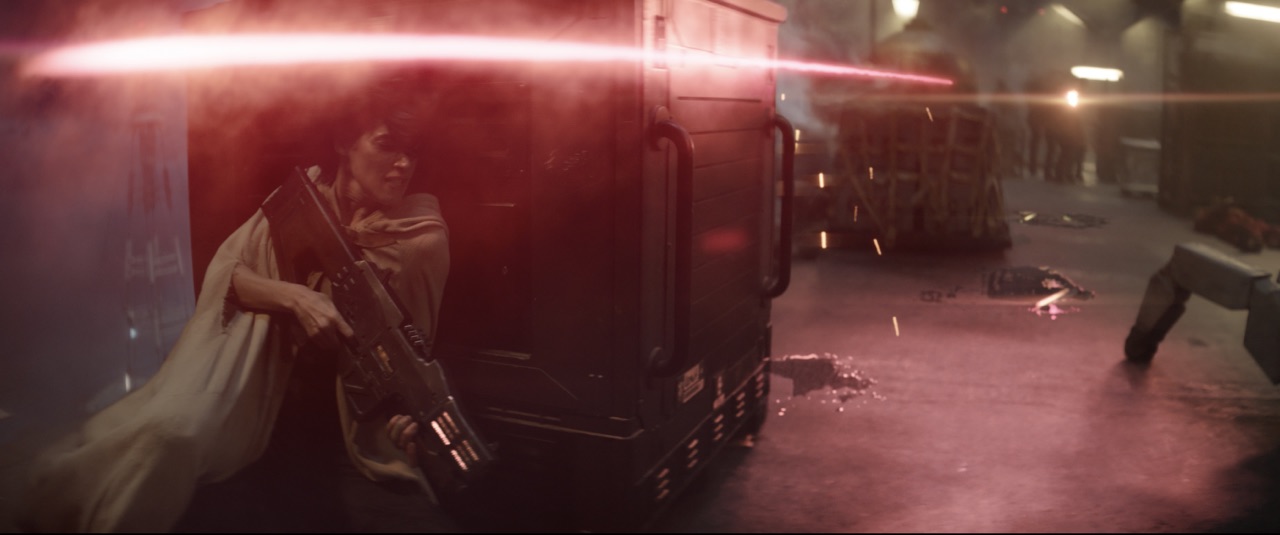
For the muzzle flashes and the tracer fire and the lava bullets, those were all a combination of a lot of discussions I had with Zack, where he’s like, ‘I envision these rounds as lava bullets.’ I’m like, ‘Okay. Well, what do we call that? What’s it look like?’ We landed on slag. So when they hit something, it’s like a molten lava, right? So we’re like, ‘That’s cool. We like that. Let’s improve on that. But how do we get from A to B? Actually, A, B, to C.’
“A” was the muzzle flash, and so we were at the mercy at times of the interactive, which would decay over multiple frames. Zack doesn’t like single-flash muzzles. He likes it over multiple frames. It’s Zack’s signature, if you will. And so we talked about, ‘Okay, there’s a muzzle flash, but then there’s this big distortion bubble that comes with these guns, and then there’s a little bit of the gas off.’ So it worked really well, and it took a long time to develop. And then that’s the “A” portion, nailed it! And we got the “C” portion, the lava bullets. And then the in-between, the “B” was the tracer fire.
I wanted it to be grounded in tracer fire and tracer-fire look. But I knew that if we started with that and then added our optic pass over all of our shots–so again, talking about the anamorphic lenses for a second. On Army, we learned a lot from the Dream Lenses, and we decided that this time around, we would create a custom bokeh board, and mapped and shot a ton of optical irregularities and flares, like days and days’ worth of them, to create this library of anomalies we could replicate in our CG and hybrid shots. From this library the team at Framestore led by Robert Winter and Ken McGaugh’s team at WetaFX created a digital lens package that mirrored the practical set 1:1. It was awesome, we could apply any flare, any distortion, any optical treatment to any shot with a couple clicks of a button. We had the ability to say ‘let’s add the A-35mm optical to this shot, but have the B-50mm distortion on it.’
We had full control, and that really also helped mirror the unique look of the practical footage, all the available light shooting style inspired by Day’s of Heaven. Again, trying to be subtle enough, but also cohesive, so the visual language was established and correct across all the shots, whether they were partially digital, fully digital, or just tracer fire. And so all those little pieces together made the weapon fire a nice little piece.
b&a: What about for the dust plumes from the spaceships?
Marcus Taormina: We took reference all along the board, and Dune did a fantastic job with their dust. And so we go, ‘We want to respect that, but how do we make it better?’ We talked a lot about those reference pieces and about how we wanted it, again, to feel gritty, what worked for those, and where we could improve on them while still fitting it within our world. I think my favourite shot of the freighter landing is when it first arrives on Neu-Wodi, because not only is is this massive dust plumb that killed Framestore resources and took very long to render – it’s got amazing lighting qualities to it, amazing volume to it – but there’s also the believability that this huge spaceship is very difficult to steer, and so Kai’s a little sloppy with it, that detail is in the animation, and in the sputtering engine that blows out and causes a black smoke trail to camera.
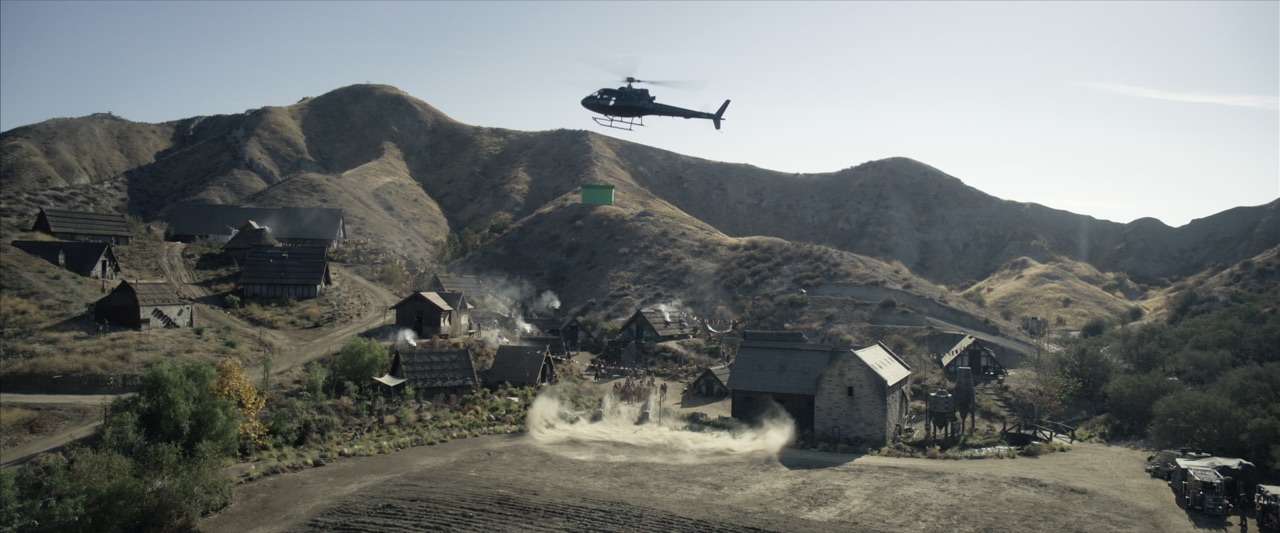

We tried to do practical dust when we could, and then we mirrored that with our digital dust. There’s some shots that are interwoven digital and practical, and it just sells it when the cast is getting pelted by real dirt. We feel it in our hair. I mean, I know I felt it multiple days after filming it in my hair! When you’re in it and you’re getting blown by that stuff, it just adds that whole other level of chaos. Again, going back to your gritty quality, it adds to the realism of it. It’s just so impactful.
The bird bennu
b&a: For the bennu, I love the closeup interaction with Tarak, but then I also love the flying shots. How did you manage that interaction with the actor, but then also the flying interaction with the actor?
Marcus Taormina: When we were in the corral on set, we had a parallelogram our special effects team made and also controlled. So there was that factor. Then there was our stunt performer, Spider, who had a green buck head of the bennu, with also a backpack that was tethered to the ropes. I knew that we’d probably end up replacing some of the rope, but the ones that we didn’t, when he whips sideways and the parallelogram whips sideways, you’re going to get the stunt performers that are at the other end of the rope doing that ‘Woahh’ motion, and it sells it all because it’s all cohesive together. So what was great about the corral was that Spider was open to suggestions, and he just lives in the characters once you tell him what, and who they are. Of course, all of that we had to paint out and replace, but the cast performances were tied to the majority of the digital creature that we put in there.


For the flight sequence, we shot it in a backlot and on pavement and surrounded by a little cove of greenscreens. I spoke to Zack with Bob Winter, our Framestore visual effects supervisor who was on set with me and said “Zack, you can film your anamorphic cameras. Do one or two of those. But I want you to film three of them surrounding the set as spherical, and lock them off.’ I said, ‘I know that we can do the anamorphic look. We have the digital lens package now. Just trust us.’ And he’s like, ‘Great, go do it’. I appreciated that trust, as in the moment, on-the-day, you have one shot to film this action.
And so we just shot the action as discussed. We shot what the storyboards were. It was never previs’d. We said, ‘Okay, now we have the ability to go and postvis it and actually create these shots, keeping in mind the camera dialogue from the rest of the movie.’ So what we did was, we took a combination of edited anamorphic plates, which are a lot of the sweeping shots, and then we took all the locked plates and recomposed and reanimated them, in a sense, where they’re postage-stamped at times, but you have the sway and kinetic energy of the buck from the stunt performers moving it around as it is suspended from cables. And then we had an opportunity to shrink them down and scale them towards the camera and things like that, where if we had previs’d it and we were at the mercy of what we previs’d, we wouldn’t have had the opportunity to expand on it. So we actually postvis’d it, but we did it in a way that got us closer to the first pass animation, and a great assembly edit that told the story early on, netting us valuable time to refine the shots to make them look spectacular.
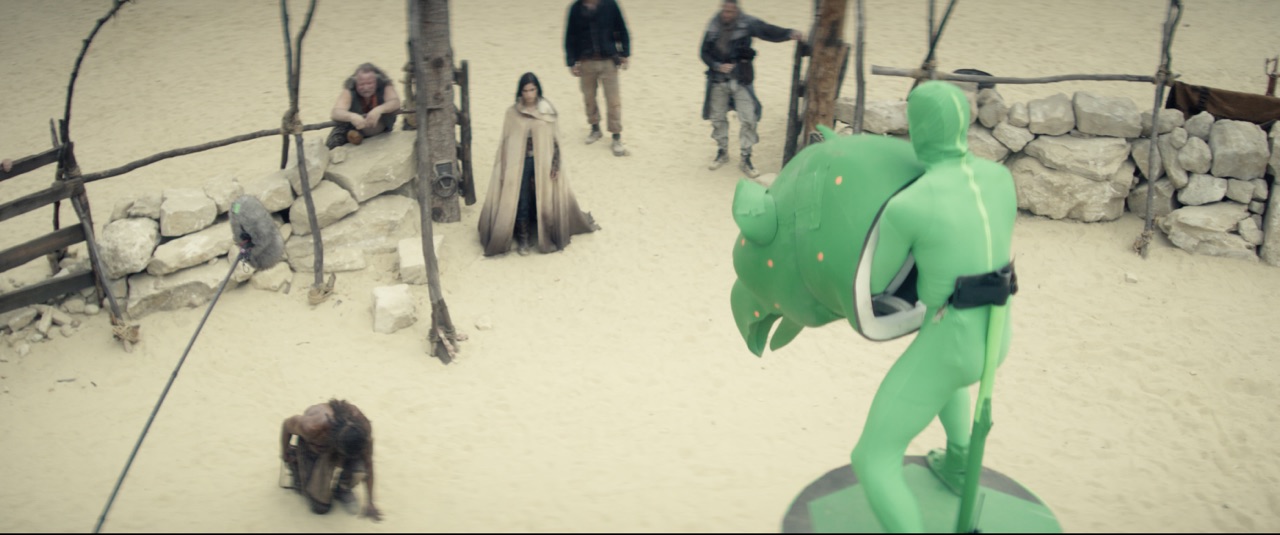
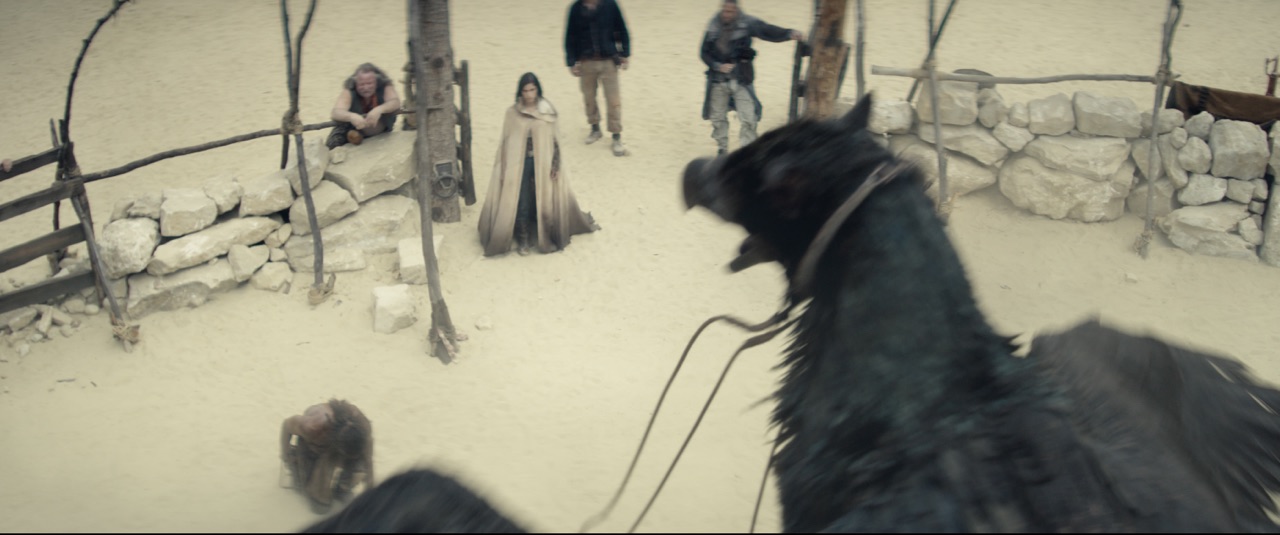
In that sequence, we could have just done all digital-doubles, but Staz as Tarak had such good performances, and that’s his performance. So we decided that wherever we could keep him, which is actually the majority of the shots that aren’t violently smashing the cliff, we kept him. And so that is his performance, and that performance lives throughout the sequence as it crescendos, and he’s in his moment as Tarak becoming one with the Bennu.
To parallel this feeling, we made sure the environment opened up to become a beautiful, majestic landscape. And then when they land back in the corral, you get the little nudge of the Bennu’s head towards Tarak, and many people don’t know, but that was something that happened organically with Spider just kind of nudging the head enough that Staz reacts to acknowledge her. It’s just those subtleties that really sell it and add depth to the digital characters.
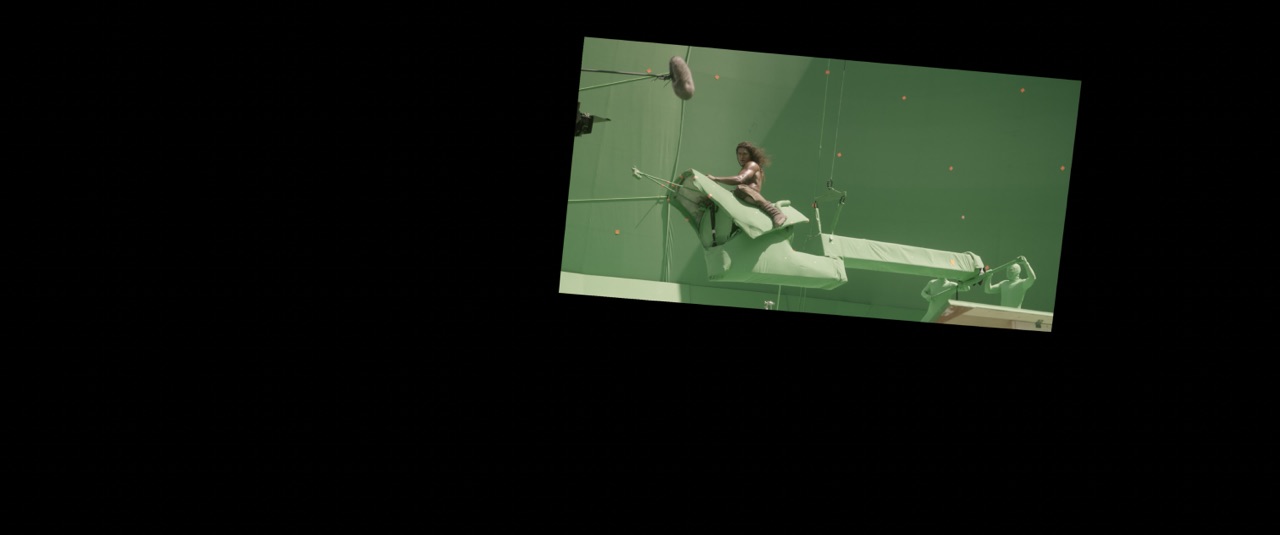

Spider-sense
b&a: Another great creature was the spidery one, Harmada. Again, I’m not totally sure whether that’s an actor in make-up effects for the face and then just you’re adding the extra spider, or whether that’s a completely CG creature.
Marcus Taormina: We talked about it early on to do it all digital, but I didn’t want to, and Zack didn’t want to either. When we finally got Jenna Malone and landed her in this role, it’s like, ‘Oh, yeah, Jenna’s going to have an amazing performance with Bae Doona, and we have to honor that and sell that.’ So what we did was, special effects made this swivel rig. And we had five or six stunt performers moving the rig, but also with pool noodles to interact as the Spider’s legs with Doona. So when Doona blocks, she’s blocking a pool noodle, which becomes a leg, so on and so forth.

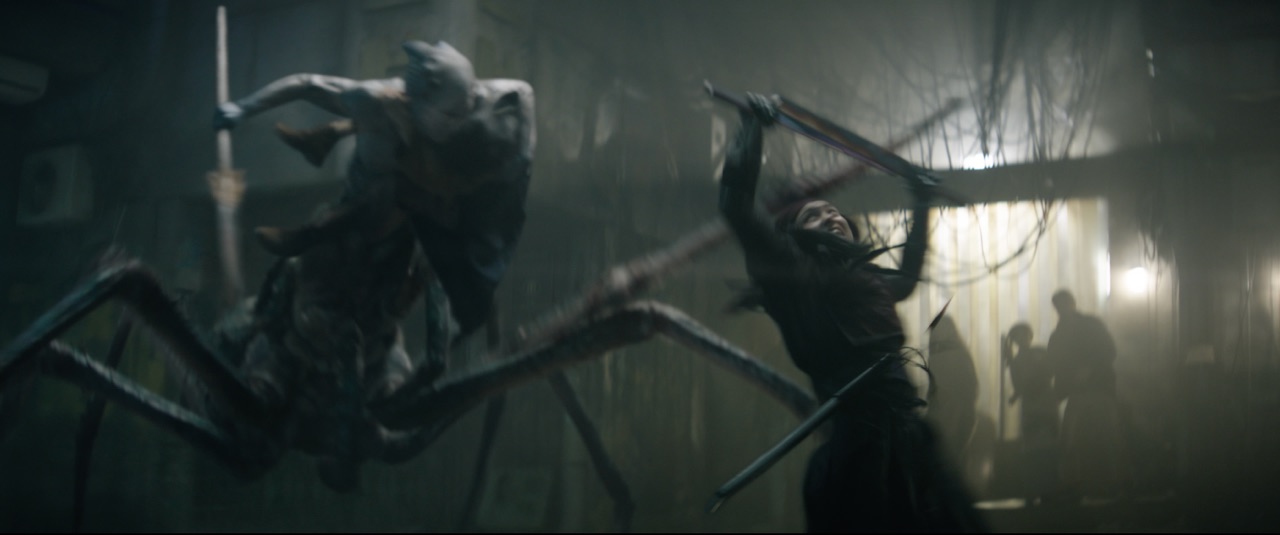


Then it’s just this cohesive marriage of stunts, special effects, Jenna’s performance, Doona’s performance, and just all of that timed out perfectly. When the swivel rig comes this way, we hit 3, 2, 1, and then Jenna goes up, and that’s when the spider rears up. The sequence was very difficult to film, It was very nerve-wracking for me all the way through post due to the layered choreography and gigantic CG spider that obviously wasn’t on set. When we finally we got one of the first test shots, I’m like, ‘Yes, it’s going to work!” And believe it or not, about 90% of that sequence is Jenna Malone in make-up effects, where we digitally seam her at the navel and sometimes around the bust area. Framestore did that amazing work and took a lot of care in creating that creature.
The performance of King Levitica
b&a: Levitica was very cool, and I was sort of transfixed by his design. Was that a stand-in actor and then a performance capture approach?
Marcus Taormina: This is where Zack’s really great as a director because he trusts everybody. I came to him, and I said, ‘Look, I know Levitica is a digital creature, but I feel like we can get a performance in there that’s really magical.’ And that’s where Tony Amendola came in. So with Tony we said, ‘We’re going to dress you as Levitica, so you feel it, and we’re going to do facial capture of your performance with the intention of translating that performance over to the digital creature.’ That was important because, again, I wanted the subtlety, but also to support the subtle nuanced performance that’s there and all Tony. My job involves a lot of things all at once, but I’m always careful about it. I try to remind myself that we always want the performance first. We want to support the cast and the heart and soul of the story, characters, creatures or environments as best we can as creators in our own right.
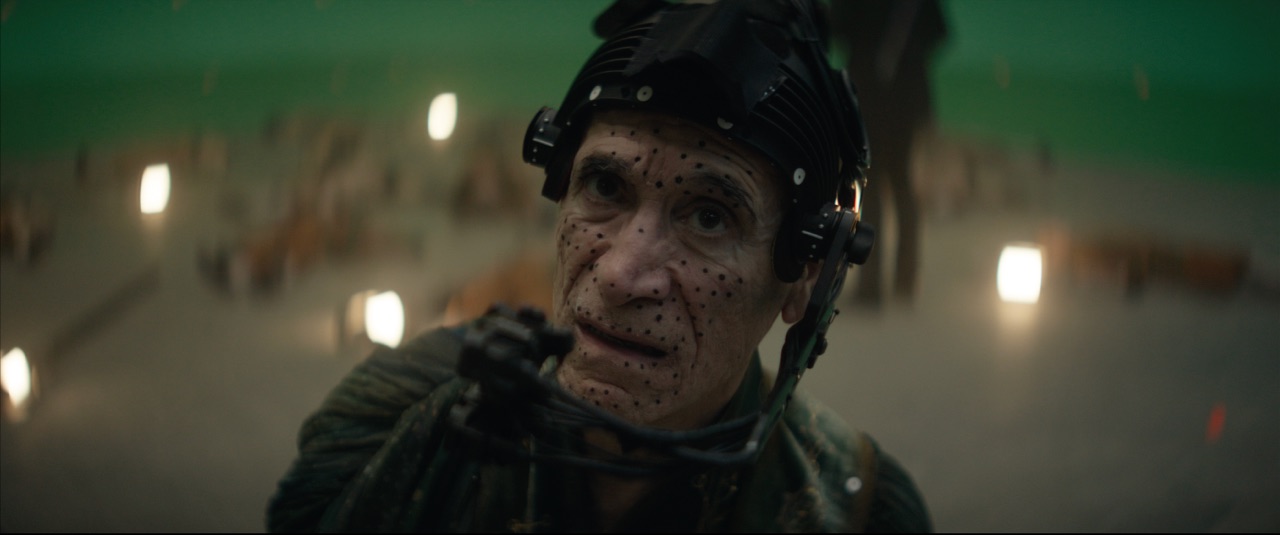
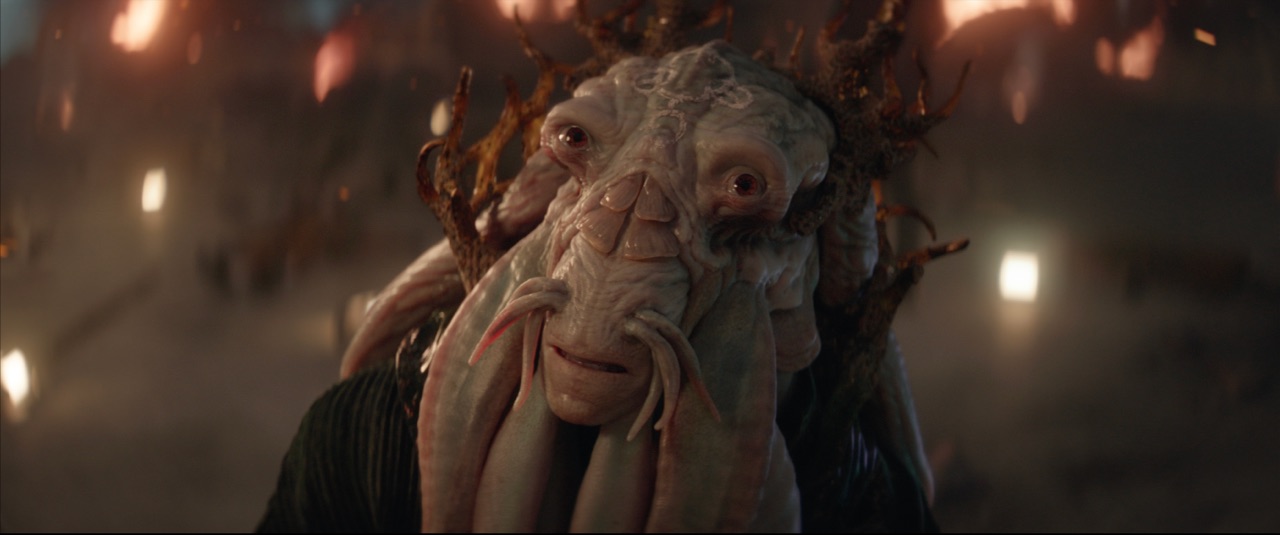
In post, the talented Wētā FX team led By Robin Hollander respected Tony’s performance and understood it was just so rich and soulful. We had a bunch of discussions about translation of the facial data and retargeting when we could, and keyframe animating when we couldn’t while always respecting Tony’s on-set performance. It’s the subtleties in that performance, like his brow wrinkles and his upper mouth curl, or when he winces, all those details very important to carry over through the animation and into the creature. And so we tried to match his performance one-to-one as best we could.
The intention was to do a full just a digital head, but what ended up happening is because his tentacles had weight and they shouldn’t be interacting and moving his wardrobe, we ended up replacing the wardrobe as well digitally. So it ended up becoming a full digital character. But if you look at the plates of Tony compared to the plates of the character, you feel that emotion, and there’s a richness to Tony. And for Levitica too, there was a richness to him, and there’s a soulfulness to him, and that’s what we really tried to strive to preserve.
Exoskeletal restraints
b&a: Finally, it might not be a big visual effects element, but those exoskeletal restraints, there was something I really liked about those, although they also scared me. What were the VFX challenges there with those?
Marcus Taormina: Those were called ecto-restraints or ecto-shackles in the script. We call them Beetlejuice chairs while shooting and through post for obvious reasons. They were a combination of stunts of practical special effects and digital effects. For the first capture, when they throw down the box in Providence, it’s obviously a real box, but when we cut back to the box after Kora and Gunnar’s lines, its a digital replica of that same box that explodes open and yanks the actor backwards, with that action happening on stunt wires, with two or three stunt performers acting as the BJC spine, catching the cast member at a pre-determined depth.
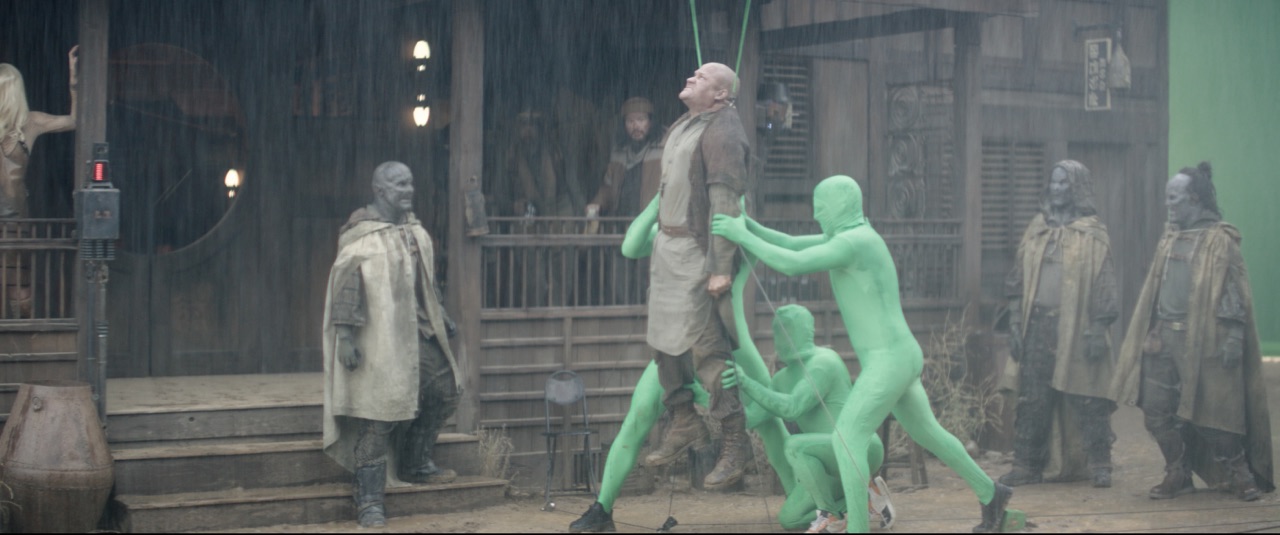

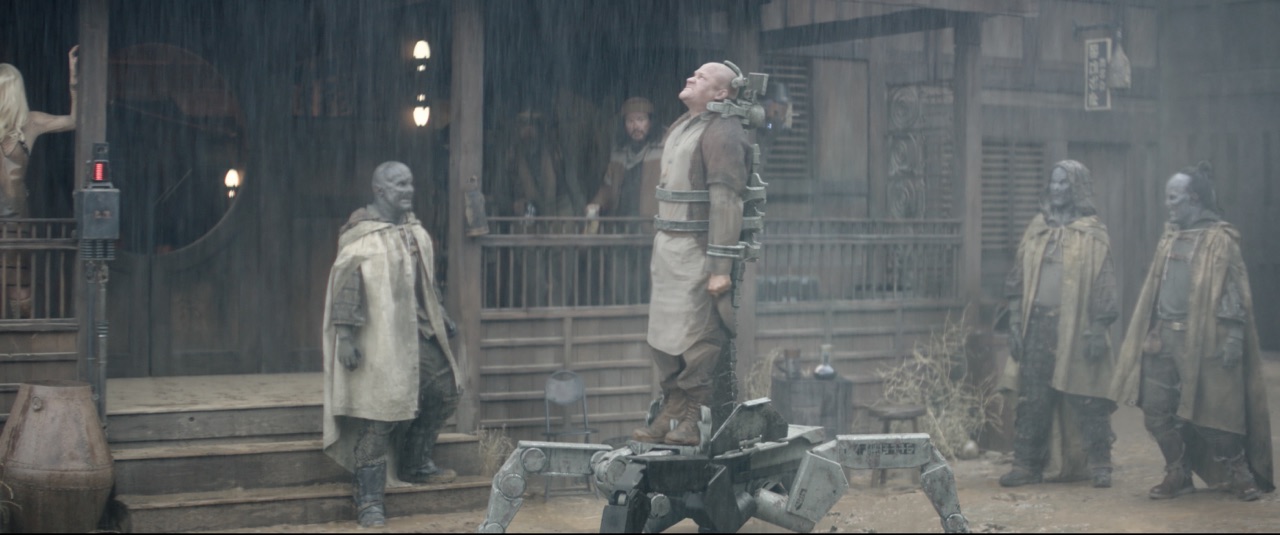
When he clicks in and is permanently restrained, we are in a hybrid practical and digital shot that transitions into forward movement with a radio controlled special-effects rig on a guided track with digital legs. We had to replace part of the ground plane digitally with all the interaction in the wet puddles on the ground when it “walked” forward from its capture position. It’s a really great mix between practical and digital, and I know Bryan Litson and team at Framestore Vancouver had an awesome time designing these chairs. It was fun to watch the chairs develop into a creature of its own as our exploration in post continued. We are hopeful the audience can’t really tell where it switches over from digital to practical, and vice-versa.

